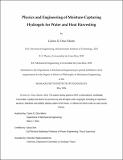Physics and Engineering of Moisture-Capturing Hydrogels for Water and Heat Harvesting
Author(s)
Díaz-Marín, Carlos D.
DownloadThesis PDF (4.594Mb)
Advisor
Chen, Gang
Terms of use
Metadata
Show full item recordAbstract
Moisture in the air represents a vast freshwater and energy resource which can be leveraged to mitigate the critical water scarcity and decarbonization challenges. In particular, moisture sorption offers a pathway for decentralized and geography-independent freshwater production from humidity through sorption-based atmospheric water harvesting. Similarly, the large heat released during moisture sorption can be used for building decarbonization through high energy density thermal energy storage. A major bottleneck towards realizing these technologies with the desired performance and large scalability lies in the sorbent material, which controllably captures and releases the moisture from the air. The last two hundred years have seen the exploration and development of numerous sorbents. However, these sorbents still suffer from performance limitations, limited scalability, and/or high cost, severely preventing them from being used for widespread atmospheric water harvesting and thermal energy storage. Recently, hydrogel-salt composites have shown potential to overcome these previous limitations due to their highly scalability, low cost, extreme capacity to capture moisture even in arid conditions, and high speed to capture and release the moisture. All these properties make hydrogel-salt composites attractive candidates for largescale sorption. Despite these promising results, major limitations in our fundamental knowledge of hydrogel-salt composites remain. These limitations block further material-level and system-level optimization as well as their long-term demonstration in systems that address the pressing water and energy challenges. For instance, there is critical knowledge gap between our understanding of the sorption performance properties and the hydrogel-salt composite physical and chemical composition. This knowledge gap has forced the development of novel materials by trial-and-error, limited the material performance, and prevented system-level design and optimization. Additionally, beyond performance, the durability of these materials, which is critical for their application use, has been understudied, hindering their system-level use. In this thesis, we develop thermodynamic, transport, and degradation descriptions for hydrogel-salt composites and we leverage this knowledge to exceed state-of-the-art performances. We first develop and experimentally validate thermodynamic models enabling the prediction and design of the uptake and enthalpy of hydrogel-salt composites and transport models for the prediction and design of the sorptiondesorption kinetics of hydrogel-salt composites. We then use this knowledge to synthesize hydrogels that can capture and retain maximized amounts of moisture from the air (1.8 kg of moisture per kg of material at 30% relative humidity), exceeding the uptake of previously demonstrated sorbents. Lastly, we study the metal-mediated degradation of hydrogel-salt composites at different conditions and use this knowledge to implement a simple strategy that achieves high material durability (>8 months). Altogether, these results tackle key bottlenecks on the development of hydrogel salt-composites enabling their careful design for superior performance and long-term durability, which is critical for low-cost operation. This represents a major step to use moisture through sorbent materials to address the water scarcity and building decarbonization challenges.
Date issued
2024-05Department
Massachusetts Institute of Technology. Department of Mechanical EngineeringPublisher
Massachusetts Institute of Technology